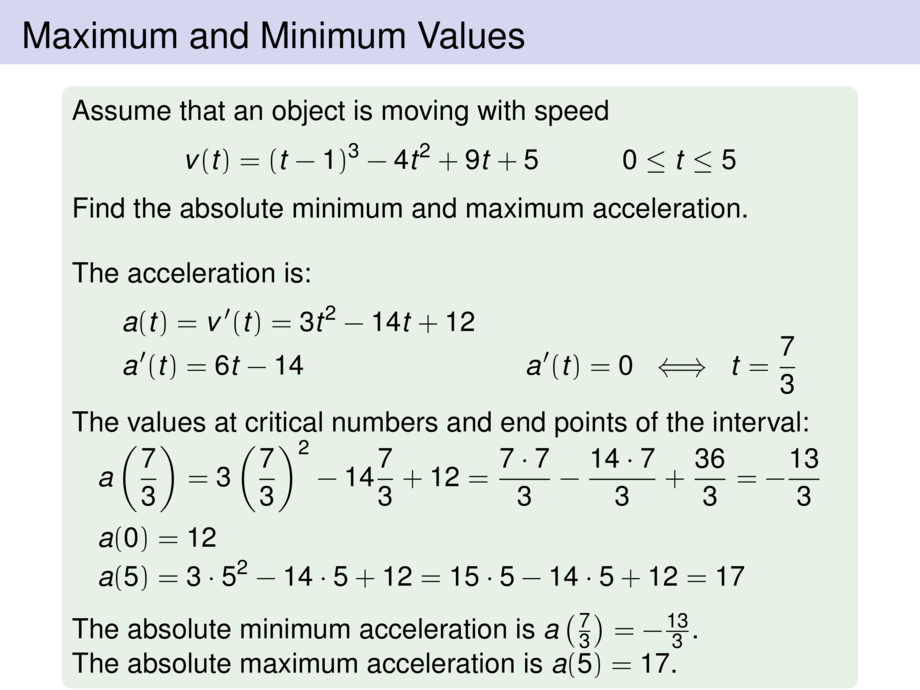



































































































185/209
\begin{frame}
\frametitle{Maximum and Minimum Values}
\begin{exampleblock}{}
Assume that an object is moving with speed
\begin{talign}
v(t) = (t-1)^3 - 4t^2 + 9t + 5 \quad\quad\quad 0\le t \le 5
\end{talign}%
Find the absolute minimum and maximum acceleration.
\bigskip
\only<-11>{%
\pause
The acceleration is:
\begin{talign}
a(t) = v'(t) = \mpause[1]{ 3(t-1)^2 - 8t + 9}
\mpause[2]{= 3t^2 - 14t + 12}
\end{talign}
\pause\pause\pause
Since $a$ is cont. on $[0,5]$ we can use Closed Interval Method.
\begin{talign}
&a'(t) = \mpause[1]{ 6t - 14 }
&&\mpause[2]{a'(t) = 0 \;\iff\; }\mpause[3]{t = \frac{7}{3}}
\end{talign}
\pause\pause\pause\pause
The only critical number is $\frac{7}{3}$. \pause
Note that $\frac{7}{3}$ is in $[0,5]$.\\\pause
No other critical numbers since $a'(t)$ is defined everywhere.
}%
\only<12-26>{
\pause[12]
The acceleration is:
\begin{talign}
&a(t) = v'(t) = 3t^2 - 14t + 12\\[-1ex]
&a'(t) = 6t - 14 & a'(t) = 0 \;\iff\; t = \frac{7}{3}
\end{talign}
\pause
The values at critical numbers and end points of the interval:\vspace{-1ex}
\begin{talign}
&a\left(\frac{7}{3}\right) =
\mpause[1]{3\left(\frac{7}{3}\right)^2 - 14\frac{7}{3} + 12}
\mpause[2]{= \frac{7\cdot 7}{3} - \frac{14\cdot 7}{3} + \frac{36}{3}}
\mpause[3]{= -\frac{13}{3}} \\
&\mpause[4]{a(0) =}\mpause[5]{ 12}\\[-.5ex]
&\mpause[6]{a(5) =}\mpause[7]{ 3\cdot 5^2 - 14 \cdot 5 + 12}
\mpause[8]{= 15\cdot 5 - 14 \cdot 5 + 12}
\mpause[9]{= 17}
\end{talign}
\pause\pause\pause\pause\pause\pause\pause\pause\pause\pause
}%
\only<27->{
\begin{center}\vspace{-2ex}
\scalebox{.7}{
\begin{tikzpicture}[default,baseline=1cm]
{\def\diaborderx{1cm}
\def\diax{t}
\def\diay{}
\diagram{-1}{5}{-1.5}{4}{1}}
\diagramannotateyy{-1/-5,1/5,2/10,3/15}
\diagramannotatex{-1,1,2,3,4}
\diagramannotatez
\begin{scope}[cgreen,ultra thick]
\draw plot[smooth,domain=0:5,samples=30] function{ ((x-1)**3 - 4*x**2 + 9*x + 5) / 5} node[right] {$v(t)$};
\mpause[27]{
\draw[cred] plot[smooth,domain=0:5,samples=30] function{ (3*x**2 - 14*x + 12) / 5} node[above] {$a(t)$};
\node[include=cred] at (7/3,-13/3/5) {};
\node[include=cred] at (5,17/5) {};
}
\end{scope}
\end{tikzpicture}
}
\end{center}
}%
\pause[23]%
The absolute minimum acceleration is \pause$a\left(\frac{7}{3}\right) = -\frac{13}{3}$.\\\pause
The absolute maximum acceleration is \pause$a(5) = 17$.\pause\pause
\end{exampleblock}
\vspace{10cm}
\end{frame}

